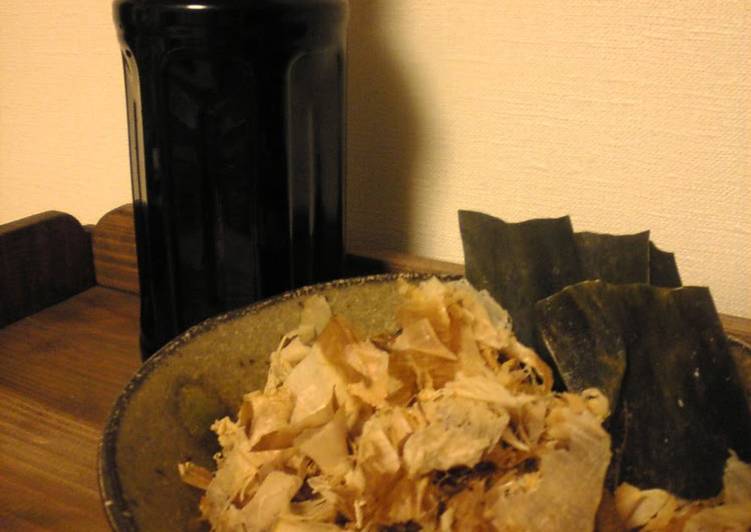All-Purpose Traditional Japanese Sauce (Dashi Soy Sauce). Dashi is very important in Japanese cooking. Making ichiban dashi using kombu and fish flakes(bonito flakes). Bonito is a tuna like fish.
 Japanese soy sauce, or shoyu, is an essential part of Japanese cuisine.
Without this sauce, many of your favorite Japanese dishes would not exist.
But did you know soy sauce comes in different flavors, colors, and textures?
You can Cook All-Purpose Traditional Japanese Sauce (Dashi Soy Sauce) using 6 ingredients and 4 steps. Here is how you achieve that.
Japanese soy sauce, or shoyu, is an essential part of Japanese cuisine.
Without this sauce, many of your favorite Japanese dishes would not exist.
But did you know soy sauce comes in different flavors, colors, and textures?
You can Cook All-Purpose Traditional Japanese Sauce (Dashi Soy Sauce) using 6 ingredients and 4 steps. Here is how you achieve that.
Ingredients of All-Purpose Traditional Japanese Sauce (Dashi Soy Sauce)
- It's 300 ml of Soy sauce.
- Lets Go Prepare 300 ml of Sake.
- Lets Go Prepare 200 ml of Mirin.
- What You needis 20 grams of Bonito flakes (about 2 big handfuls).
- What You needis 10 grams of Kombu for dashi stock (about 4 to 5 10 cm x 3 cm pieces).
- What You needis 1 of Shredded nori seaweed, white sesame seeds (for the furikake).
The dark, salty sauce you find on the table in Japanese restaurants is. All the dried ingredients that are used to make Japanese soup stock are rich in naturally occurring glutamates and provide intense flavor to the stock. Miso soup (味噌汁, misoshiru) is a traditional Japanese soup consisting of a dashi stock into which softened miso paste is mixed. In addition, there are many optional ingredients.
All-Purpose Traditional Japanese Sauce (Dashi Soy Sauce) step by step
- Put all the ingredients except the nori seaweed and sesame seeds into a pan and turn on the heat. Once it comes to a boil, turn the heat down to low and simmer. Continue simmering for 15 to 20 minutes until the liquid has reduced by 2/3..
- Take the pan off the heat, and let cool. When it's cooled, strain it through a fine meshed sieve or paper towels. You'll end up with about 500 ml of dashi..
- How to reuse leftover bonito flakes: Spread it out on parchment paper-lined baking sheet. Bake in an oven preheated to 195-210°F/90-100°C. Around the time you've forgotten about it, it will be nicely dried (about 1 hour). P.S. Be careful not heat the oven too high, this will dry out the flakes. You can also dry-roast in a frying pan..
- Add finely shredded nori seaweed and white sesame seeds, for gorgeous, delicious bonito flake furikake! Store in an airtight container in the refrigerator. I recommend eating this with rice! It's so good!.
All types of dashi impart a rich, savory taste, thanks to the naturally occurring glutamic acid in the dried ingredients the dashi stock requires. Japanese dashi is best used on the day it's made. If you have some leftover dashi, however, keep it in a covered container refrigerated for up to a week or freeze to. A wide variety of dashi soy sauce options are available to you, such as brewed, blended. In the West, dashi may well be the unsung hero of Japanese cooking.